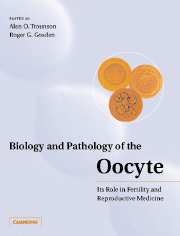Book contents
- Frontmatter
- Contents
- List of contributors
- Preface
- Part I Historical perspective
- Part II Life cycle
- Part III Developmental biology
- 6 Oocyte-specific gene expression: roles in folliculogenesis, fertilization and early development
- 7 Storage and functional recovery of molecules in oocytes
- 8 Endocrine regulation of meiosis - local and systemic hormonal influences
- 9 Checkpoint controls in mammalian oocytes
- 10 Fertilization: fate of sperm components after ICSI
- 11 Activation of the mammalian egg
- 12 Clinical applications in symmetry, asymmetry and polarity in early human development
- Part IV Pathology
- Part V Technology and clinical medicine
- Index
12 - Clinical applications in symmetry, asymmetry and polarity in early human development
from Part III - Developmental biology
Published online by Cambridge University Press: 05 August 2016
- Frontmatter
- Contents
- List of contributors
- Preface
- Part I Historical perspective
- Part II Life cycle
- Part III Developmental biology
- 6 Oocyte-specific gene expression: roles in folliculogenesis, fertilization and early development
- 7 Storage and functional recovery of molecules in oocytes
- 8 Endocrine regulation of meiosis - local and systemic hormonal influences
- 9 Checkpoint controls in mammalian oocytes
- 10 Fertilization: fate of sperm components after ICSI
- 11 Activation of the mammalian egg
- 12 Clinical applications in symmetry, asymmetry and polarity in early human development
- Part IV Pathology
- Part V Technology and clinical medicine
- Index
Summary
Introduction
Symmetries, asymmetries and polarities in the distribution of cytoplasmic components and regulatory molecules are fundamental forces that direct embryogenesis in invertebrates and lower vertebrates (Edwards and Beard, 1997, 1999a; Jeffery, 2001; Kloc et al., 2001; St. Amand and Klymkowsky, 2001). In one of the best-studied systems, the fruit fly Drosophila melanogaster, molecular and cellular interactions between the oocyte and follicle and nurse cell compartments involve relatively well-described signal transduction pathways, and establish polarities and gradients in the distribution of regulatory proteins and transcripts in the oocyte and embryo which determine cell lineage, fate and function (Cooperstock and Lipshitz, 2001; Mahowald, 2001). For the mammal, the notion that asymmetries or polarities can also be developmental forces during early embryogenesis is not new (for older studies, see reviews by Denker, 1976, 1983), but one that has received considerable attention with respect to the generation of the trophectoderm and inner cell mass (Flemming and Johnson, 1988) and, most recently, the possible origins of the embryonic axes that maybe established prior to cleavage (Gardner, 1997, 2000, 2001).
In this chapter, the findings for the human that indicate differences in the organization or distribution of cytoplasmic components in early embryos that are detectable by noninvasive methods, and which appear to have downstream influences on developmental competence, will be reviewed. A detailed treatment of molecular and organizational polarities in other systems that may have homologies in the human is beyond the scope of this chapter, and, as such, the reader's attention is directed to several recent reviews in this area (Edwards and Beard, 1997, 1999a; Scott, 2000). With respect to the human in general, and possible applications in the evaluation of embryo competence in clinical in vitro fertilization (IVF) in particular, the studies discussed represent an emerging area of research that has already provided new insights and questions concerning the origins of the differential developmental potential expressed by human embryos.
Nucleolar morphology, polarity and competence
The unique developmental potential of each human oocyte and early embryo has been recognized from the earliest days of clinical IVF (Edwards, 1986).
- Type
- Chapter
- Information
- Biology and Pathology of the OocyteIts Role in Fertility and Reproductive Medicine, pp. 163 - 182Publisher: Cambridge University PressPrint publication year: 2003
- 2
- Cited by

